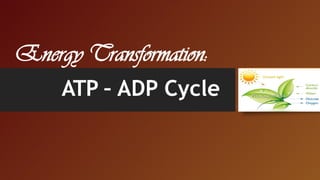
Genbio1 q2 lesson 3
- 1. Energy Transformation: ATP – ADP Cycle
- 2. Explicate the couple reaction processes and describe the role of ATP in energy coupling and transfer The learners should be able to: 1. Define ATP and ADP, 2. Describe how ATP works in cellular process, and 3. Explain coupled reaction processes and describe the role of ATP in energy coupling and transfer.
- 3. Living cells require energy from outside sources Energy flows into an ecosystem as sunlight and leaves as heat Photosynthesis generates O2 and organic molecules, which are used in cellular respiration Cells use chemical energy stored in organic molecules to regenerate ATP Overview: Life Is Work
- 5. The Flow of Energy • All life on earth depends on the flow of energy through ecosystems • All energy on the earth ultimately comes from the sun
- 6. Organisms are classified according to their energy source These are the: AUTOTROPHS • Photoautotrophs • Chemoautotrophs HETEROTROPHS • Carnivores • Herbivores • Omnivores • Scavengers • Decomposers • Detritivores
- 7. Autotrophs • organisms capable of making their own food. • plants are photoautotrophs • they use light energy from the sun to produce glucose (sugar)
- 8. Heterotrophs • organisms not capable of making their own food • they are consumers of the biosphere • they must eat plants, or other animals who eat plants to acquire indirectly the energy from the sun
- 10. What is the energy currency of the cells of autotrophs and heterotrophs? The activities of the cell are powered by a chemical fuel called adenosine triphosphate (also known as ATP).
- 11. Adenosine Triphosphate The common energy currency of cells. With one big molecule that is made of 5 smaller molecules bonded together. Adenosine Tri-phosphate
- 12. How energy is released from ATP? • ATP transfer energy from the breakdown of food molecules to cell function. • Energy is released when phosphate group (P) is removed • ADP is charge into ATP when phosphate group (P) is added.
- 13. Light energy ECOSYSTEM Photosynthesis in chloroplasts CO2 + H2O Cellular respiration in mitochondria Organic molecules + O2 ATP powers most cellular work Heat energy ATP
- 14. Redox Reactions: Oxidation and Reduction The transfer of electrons during chemical reactions releases energy stored in organic molecules This released energy is ultimately used to synthesize ATP
- 15. The three types of cellular work are: transport mechanical chemical Each is powered by the hydrolysis of ATP In the cell, the energy from the exergonic reaction of ATP hydrolysis can be used to drive an endergonic reaction How ATP Performs Work?
- 16. Fig. 8-11 (b) Mechanical work: ATP binds noncovalently to motor proteins, then is hydrolyzed Membrane protein P i ADP + P Solute Solute transported P i Vesicle Cytoskeletal track Motor protein Protein moved (a) Transport work: ATP phosphorylates transport proteins ATP ATP
- 17. Key concepts of ATP/ADP Cycle 1. ATP contains MORE energy than ADP because it has more bonds. 2. When a phosphate is REMOVED energy is RELEASED. 3. When a phosphate is ADDED energy is NEEDED.
- 18. ATP-ADP Cycle: Carbohydrates • Energy: up to 36 ATP molecules (1 glucose) • Details: • Most commonly broken down to make ATP • Not stored in large amounts
- 19. • Energy: about 146 ATP molecules (triglyceride) • Details: • Lipids store the most energy • 80% of the energy in our body ATP-ADP Cycle: Fats/Lipids
- 20. • Energy: about 36 ATP molecules BUT… • Details: • Proteins are least likely to be broken down to make ATP, • Amino acids not usually needed for energy ATP-ADP Cycle: Proteins
- 21. Energy Content of Biomolecules MOLECULES ENERGY Carbohydrates 4 calories per mg Lipid 9 calories per mg Protein 4 calories per mg
- 22. Learning Check 1. Where does plants get energy to produce its own food? 2. Consumers are also termed as . 3. When does ATP release its stored energy? 4. What molecule will be formed if 1 molecule of phosphate will be released? 5. Which of the biomolecules possessed greater amount of energy?
- 23. Answer 1.Sun 2.Heterotrophs 3.When 1 of the phosphorus is broken and released 4.ADP 5.Lipids/Fats
